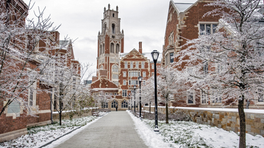Top Colleges With the Most Flexible Majors
- Austin Kern
- Jul 21, 2023
- 3 min read
Choosing a major is a crucial decision for college students as it often shapes their academic and career paths. With that said, it is important to consider which institutions are most flexible with major declarations when deciding where to attend college. In this blog post, we will delve into the differences in major declaration processes among various types of institutions, specifically focusing on the distinction between liberal arts colleges, public universities, and open curriculum colleges.
Liberal Arts Colleges
Liberal arts colleges are renowned for their emphasis on a broad education and the exploration of various disciplines. One of the defining features of these institutions is their flexible approach to major declaration. Students attending liberal arts colleges often have the opportunity to explore different academic fields before settling on a major, and usually have less stringent requirements around changing majors.
These colleges typically provide a range of introductory courses that expose students to various disciplines, allowing them to gain a better understanding of their interests and aptitudes. This exposure helps students make an informed decision about their major, ensuring they choose a path that aligns with their passions and goals.
Moreover, liberal arts colleges often encourage interdisciplinary studies, allowing students to combine different fields of study to create unique academic experiences. While public universities often have different schools to which applicants must apply to pursue majors in a specific field (for example, the McCombs School of Business at UT Austin must be applied to directly for students wishing to pursue business-related degrees), liberal arts colleges are rarely subdivided in that way: admittance to a liberal arts college will allow one to pursue any major available at that school.
High Ranking Liberal Arts Colleges: William’s College (Williamstown, MA) Pomona College (Claremont, CA) Swarthmore College (Swarthmore, PA)
Public Universities
Public universities, on the other hand, tend to offer a wider array of majors due to their larger size and broader academic offerings. While they may not emphasize exploration in the same way as liberal arts colleges, public universities often have greater flexibility in terms of major choice.
These institutions typically offer numerous programs across various fields of study, ranging from the humanities to the sciences and professional disciplines. Students attending public universities have the advantage of a broader range of options, allowing them to find a major that aligns with their interests and career aspirations.
Public universities often have more extensive resources, including research facilities and faculty expertise, which can provide students with unique opportunities for in-depth exploration within their chosen majors. However, it is worth noting that some public universities may have stricter prerequisites or admission requirements for specific programs.
High Ranking Public Universities: University of California - Berkeley (Berkeley, CA) University of Michigan - Ann Arbor (Ann Arbor, MI) University of Texas - Austin (Austin, TX)
Open Curriculum Colleges
Additionally, there is a subset of colleges known as open curriculum colleges. These- often liberal arts- colleges grant students significant freedom in designing their academic programs. At open curriculum colleges, students are not bound by traditional core requirements or mandatory courses, allowing them to shape their education according to individual interests and goals.
Open curriculum colleges believe in empowering students to take ownership of their education. They offer a wide range of courses, enabling students to explore different disciplines and create their own interdisciplinary pathways. Students attending these colleges have the freedom to explore diverse subjects without the fear of being constrained by rigid course structures or mandatory majors. A key aspect present in most open curriculum colleges (though it is also possible, though less common, elsewhere) is the ability to design one’s own major. While working closely with academic advisors and faculty members, students may choose courses from a variety of fields and disciplines to serve as the basis of a highly unique and individualized degree.
High Ranking Open Curriculum Colleges: Amherst College (Amherst, MA) Brown University (Providence, RI) Grinnell College (Grinnell, IA)
Conclusions
When it comes to major declarations, the level of flexibility varies among different types of institutions. Liberal arts colleges provide a strong emphasis on exploration, encouraging students to explore multiple academic fields before committing to a major. Public universities, on the other hand, offer a wider array of majors and often provide extensive resources for in-depth exploration. Open curriculum colleges, with their student-centered approach, grant the most significant freedom for students to shape their own educational experiences.
With all these options to consider, choosing the type of college that fits your major goals and learning style can be tough. Our College Admissions Counseling team can talk through your preferences and goals to help you select universities that match the flexibility and the variety you desire. Contact the front desk to schedule a meeting with one of our experienced Counselors soon!
















